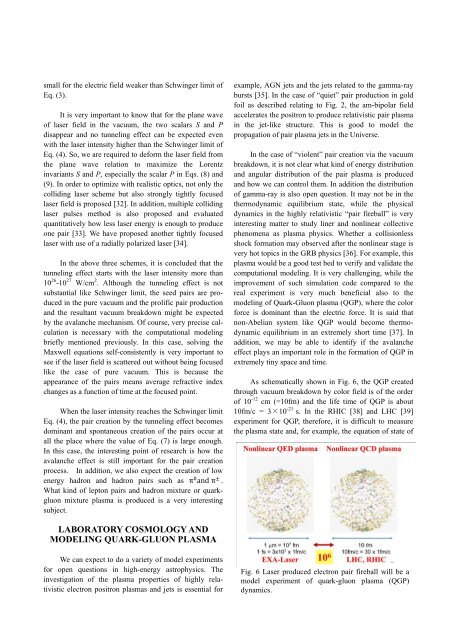Proceedings of International Conference on Physics in ... - KEK
Proceedings of International Conference on Physics in ... - KEK
Proceedings of International Conference on Physics in ... - KEK
You also want an ePaper? Increase the reach of your titles
YUMPU automatically turns print PDFs into web optimized ePapers that Google loves.
small for the electric field weaker than Schw<strong>in</strong>ger limit <str<strong>on</strong>g>of</str<strong>on</strong>g><br />
Eq. (3).<br />
It is very important to know that for the plane wave<br />
<str<strong>on</strong>g>of</str<strong>on</strong>g> laser field <strong>in</strong> the vacuum, the two scalars S and P<br />
disappear and no tunnel<strong>in</strong>g effect can be expected even<br />
with the laser <strong>in</strong>tensity higher than the Schw<strong>in</strong>ger limit <str<strong>on</strong>g>of</str<strong>on</strong>g><br />
Eq. (4). So, we are required to deform the laser field from<br />
the plane wave relati<strong>on</strong> to maximize the Lorentz<br />
<strong>in</strong>variants S and P, especially the scalar P <strong>in</strong> Eqs. (8) and<br />
(9). In order to optimize with realistic optics, not <strong>on</strong>ly the<br />
collid<strong>in</strong>g laser scheme but also str<strong>on</strong>gly tightly focused<br />
laser field is proposed [32]. In additi<strong>on</strong>, multiple collid<strong>in</strong>g<br />
laser pulses method is also proposed and evaluated<br />
quantitatively how less laser energy is enough to produce<br />
<strong>on</strong>e pair [33]. We have proposed another tightly focused<br />
laser with use <str<strong>on</strong>g>of</str<strong>on</strong>g> a radially polarized laser [34].<br />
In the above three schemes, it is c<strong>on</strong>cluded that the<br />
tunnel<strong>in</strong>g effect starts with the laser <strong>in</strong>tensity more than<br />
10 26 -10 27 W/cm 2 . Although the tunnel<strong>in</strong>g effect is not<br />
substantial like Schw<strong>in</strong>ger limit, the seed pairs are pro-<br />
duced <strong>in</strong> the pure vacuum and the prolific pair producti<strong>on</strong><br />
and the resultant vacuum breakdown might be expected<br />
by the avalanche mechanism. Of course, very precise cal-<br />
culati<strong>on</strong> is necessary with the computati<strong>on</strong>al model<strong>in</strong>g<br />
briefly menti<strong>on</strong>ed previously. In this case, solv<strong>in</strong>g the<br />
Maxwell equati<strong>on</strong>s self-c<strong>on</strong>sistently is very important to<br />
see if the laser field is scattered out without be<strong>in</strong>g focused<br />
like the case <str<strong>on</strong>g>of</str<strong>on</strong>g> pure vacuum. This is because the<br />
appearance <str<strong>on</strong>g>of</str<strong>on</strong>g> the pairs means average refractive <strong>in</strong>dex<br />
changes as a functi<strong>on</strong> <str<strong>on</strong>g>of</str<strong>on</strong>g> time at the focused po<strong>in</strong>t.<br />
When the laser <strong>in</strong>tensity reaches the Schw<strong>in</strong>ger limit<br />
Eq. (4), the pair creati<strong>on</strong> by the tunnel<strong>in</strong>g effect becomes<br />
dom<strong>in</strong>ant and sp<strong>on</strong>taneous creati<strong>on</strong> <str<strong>on</strong>g>of</str<strong>on</strong>g> the pairs occur at<br />
all the place where the value <str<strong>on</strong>g>of</str<strong>on</strong>g> Eq. (7) is large enough.<br />
In this case, the <strong>in</strong>terest<strong>in</strong>g po<strong>in</strong>t <str<strong>on</strong>g>of</str<strong>on</strong>g> research is how the<br />
avalanche effect is still important for the pair creati<strong>on</strong><br />
process. In additi<strong>on</strong>, we also expect the creati<strong>on</strong> <str<strong>on</strong>g>of</str<strong>on</strong>g> low<br />
energy hadr<strong>on</strong> and hadr<strong>on</strong> pairs such as π and π ± .<br />
What k<strong>in</strong>d <str<strong>on</strong>g>of</str<strong>on</strong>g> lept<strong>on</strong> pairs and hadr<strong>on</strong> mixture or quark-<br />
glu<strong>on</strong> mixture plasma is produced is a very <strong>in</strong>terest<strong>in</strong>g<br />
subject.<br />
LABORATORY COSMOLOGY AND<br />
MODELING QUARK-GLUON PLASMA<br />
We can expect to do a variety <str<strong>on</strong>g>of</str<strong>on</strong>g> model experiments<br />
for open questi<strong>on</strong>s <strong>in</strong> high-energy astrophysics. The<br />
<strong>in</strong>vestigati<strong>on</strong> <str<strong>on</strong>g>of</str<strong>on</strong>g> the plasma properties <str<strong>on</strong>g>of</str<strong>on</strong>g> highly rela-<br />
tivistic electr<strong>on</strong> positr<strong>on</strong> plasmas and jets is essential for<br />
example, AGN jets and the jets related to the gamma-ray<br />
bursts [35]. In the case <str<strong>on</strong>g>of</str<strong>on</strong>g> “quiet” pair producti<strong>on</strong> <strong>in</strong> gold<br />
foil as described relat<strong>in</strong>g to Fig. 2, the am-bipolar field<br />
accelerates the positr<strong>on</strong> to produce relativistic pair plasma<br />
<strong>in</strong> the jet-like structure. This is good to model the<br />
propagati<strong>on</strong> <str<strong>on</strong>g>of</str<strong>on</strong>g> pair plasma jets <strong>in</strong> the Universe.<br />
In the case <str<strong>on</strong>g>of</str<strong>on</strong>g> “violent” pair creati<strong>on</strong> via the vacuum<br />
breakdown, it is not clear what k<strong>in</strong>d <str<strong>on</strong>g>of</str<strong>on</strong>g> energy distributi<strong>on</strong><br />
and angular distributi<strong>on</strong> <str<strong>on</strong>g>of</str<strong>on</strong>g> the pair plasma is produced<br />
and how we can c<strong>on</strong>trol them. In additi<strong>on</strong> the distributi<strong>on</strong><br />
<str<strong>on</strong>g>of</str<strong>on</strong>g> gamma-ray is also open questi<strong>on</strong>. It may not be <strong>in</strong> the<br />
thermodynamic equilibrium state, while the physical<br />
dynamics <strong>in</strong> the highly relativistic “pair fireball” is very<br />
<strong>in</strong>terest<strong>in</strong>g matter to study l<strong>in</strong>er and n<strong>on</strong>l<strong>in</strong>ear collective<br />
phenomena as plasma physics. Whether a collisi<strong>on</strong>less<br />
shock formati<strong>on</strong> may observed after the n<strong>on</strong>l<strong>in</strong>ear stage is<br />
very hot topics <strong>in</strong> the GRB physics [36]. For example, this<br />
plasma would be a good test bed to verify and validate the<br />
computati<strong>on</strong>al model<strong>in</strong>g. It is very challeng<strong>in</strong>g, while the<br />
improvement <str<strong>on</strong>g>of</str<strong>on</strong>g> such simulati<strong>on</strong> code compared to the<br />
real experiment is very much beneficial also to the<br />
model<strong>in</strong>g <str<strong>on</strong>g>of</str<strong>on</strong>g> Quark-Glu<strong>on</strong> plasma (QGP), where the color<br />
force is dom<strong>in</strong>ant than the electric force. It is said that<br />
n<strong>on</strong>-Abelian system like QGP would become thermo-<br />
dynamic equilibrium <strong>in</strong> an extremely short time [37]. In<br />
additi<strong>on</strong>, we may be able to identify if the avalanche<br />
effect plays an important role <strong>in</strong> the formati<strong>on</strong> <str<strong>on</strong>g>of</str<strong>on</strong>g> QGP <strong>in</strong><br />
extremely t<strong>in</strong>y space and time.<br />
As schematically shown <strong>in</strong> Fig. 6, the QGP created<br />
through vacuum breakdown by color field is <str<strong>on</strong>g>of</str<strong>on</strong>g> the order<br />
<str<strong>on</strong>g>of</str<strong>on</strong>g> 10 -12 cm (=10fm) and the life time <str<strong>on</strong>g>of</str<strong>on</strong>g> QGP is about<br />
10fm/c = 3×10 -21 s. In the RHIC [38] and LHC [39]<br />
experiment for QGP, therefore, it is difficult to measure<br />
the plasma state and, for example, the equati<strong>on</strong> <str<strong>on</strong>g>of</str<strong>on</strong>g> state <str<strong>on</strong>g>of</str<strong>on</strong>g><br />
Fig. 6 Laser produced electr<strong>on</strong> pair fireball will be a<br />
model experiment <str<strong>on</strong>g>of</str<strong>on</strong>g> quark-glu<strong>on</strong> plasma (QGP)<br />
dynamics.













